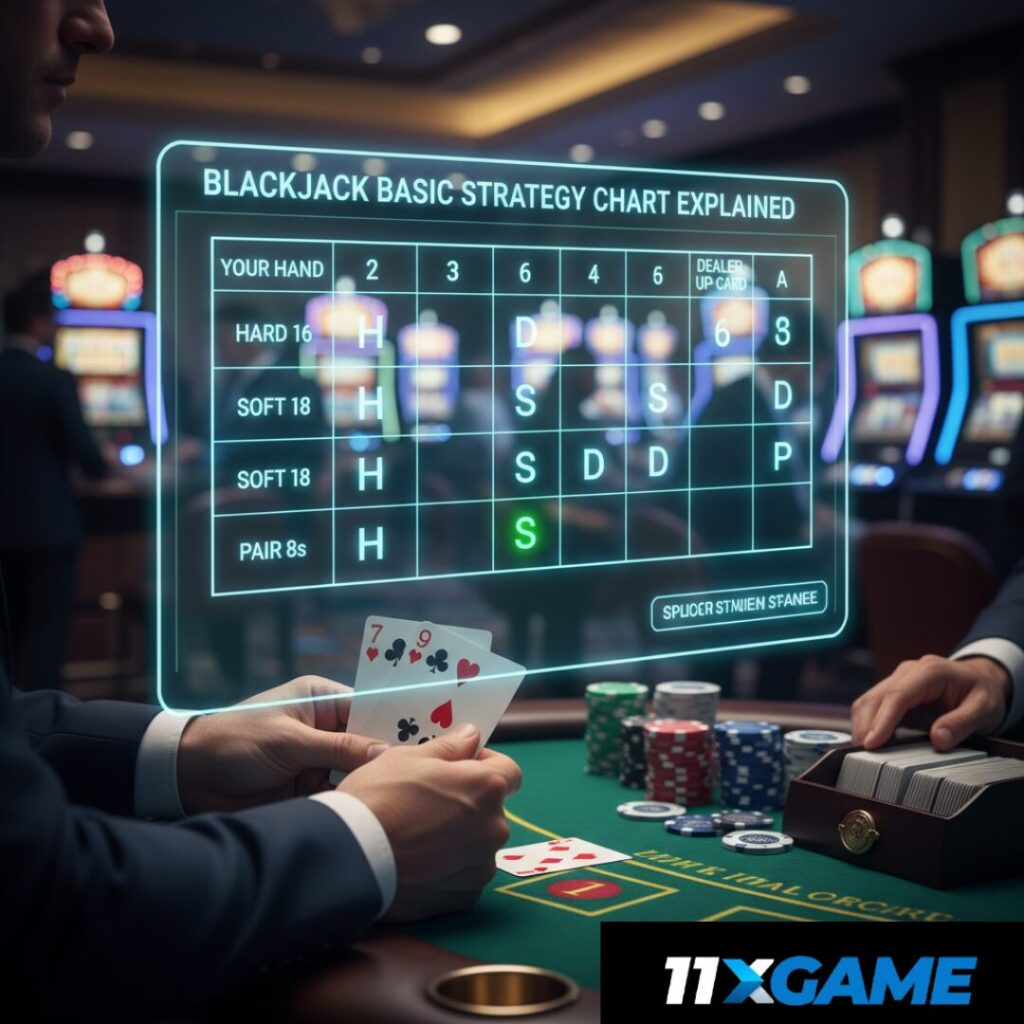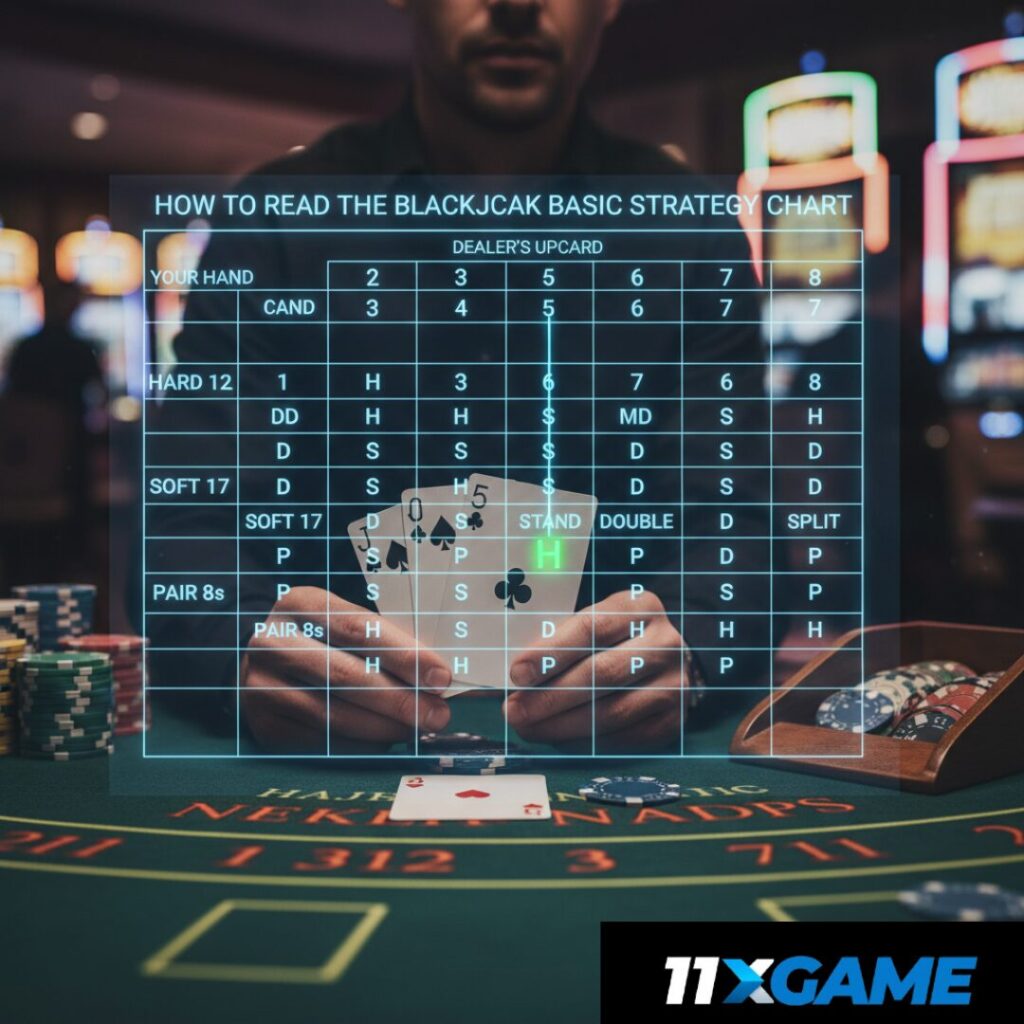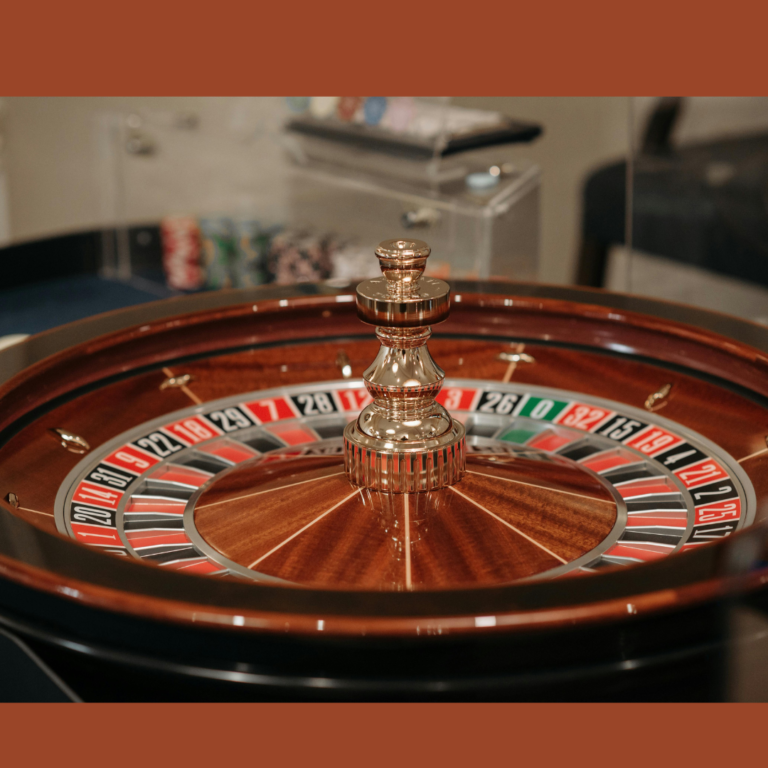Unlocking Blackjack Basic Strategy Chart Explained: 10 Ways to Boost Your Wins in 2025
Blackjack basic strategy chart explained is your ultimate guide to turning the tables on the casino. Whether you’re a newbie stepping into the thrill of the game or a seasoned player looking to sharpen your edge, understanding this chart can dramatically improve your odds. It’s not about luck alone—it’s about making smart, calculated decisions based on math and probability. In this post, we’ll dive deep into what the chart is, how it works, and why it’s a game-changer for anyone serious about blackjack.
Imagine sitting at a bustling casino table, cards in hand, and knowing exactly when to hit, stand, or double down. That’s the power of the blackjack basic strategy chart explained. Developed through rigorous computer simulations analyzing millions of hands, this tool minimizes the house edge to as low as 0.5% when used correctly. No more guessing— just pure strategy that puts you in control.

But why does it matter in 2025? With online platforms evolving and more variations of the game available, mastering the basics ensures you’re always one step ahead. Let’s break it down step by step, from the fundamentals to advanced tips, so you can apply it seamlessly.
What Is a Blackjack Basic Strategy Chart?
At its core, the blackjack basic strategy chart is a visual grid that tells you the optimal move for every possible hand combination against the dealer’s upcard. It’s divided into sections for hard hands (no ace or ace counted as 1), soft hands (ace counted as 11), and pairs that can be split.
This chart isn’t some mystical secret—it’s grounded in statistics. For instance, it considers the fact that there are more 10-value cards in the deck than any other, influencing decisions like standing on a hard 17 against a dealer’s 6.
Think of it as a roadmap. Without it, you’re navigating blind; with it, you’re optimizing every play. And the best part? It’s legal to use in most casinos, as long as you’re not counting cards.
The History Behind Blackjack Basic Strategy Chart Explained
The blackjack basic strategy chart explained didn’t appear overnight. It traces back to the 1950s when mathematicians like Roger Baldwin crunched numbers using early computers. Their work, published in the Journal of the American Statistical Association, laid the foundation for what we use today.
By the 1960s, Edward Thorp refined it in his book “Beat the Dealer,” introducing card counting alongside basic strategy. Fast forward to now, and tools like simulations from sites such as Wizard of Odds have perfected charts for different deck counts and rules.
This evolution shows how strategy adapts to game changes, like dealers hitting soft 17, keeping it relevant for modern play.
How to Read the Blackjack Basic Strategy Chart
Reading the chart is simpler than it looks. The vertical axis lists your hand totals or pairs, while the horizontal shows the dealer’s upcard from 2 to Ace.
Common abbreviations include:
- H: Hit
- S: Stand
- D: Double down (if allowed, else hit)
- Ds: Double if allowed, else stand
- P: Split
- Su: Surrender (if available, else hit)
For example, if you have a hard 12 and the dealer shows a 3, the chart says “H” for hit. Easy, right?
Start with the hard hands section, as it’s the most common. Practice by simulating hands mentally before diving in.

Breaking Down Hard Hands in Blackjack Basic Strategy Chart Explained
Hard hands are straightforward but crucial in the blackjack basic strategy chart explained. These are totals without an ace or where the ace is 1.
Here’s a quick table for hard hands (assuming 4-8 decks, dealer hits soft 17):
| Your Hand | Dealer 2 | Dealer 3 | Dealer 4 | Dealer 5 | Dealer 6 | Dealer 7 | Dealer 8 | Dealer 9 | Dealer 10 | Dealer A |
| 8 or less | H | H | H | H | H | H | H | H | H | H |
| 9 | H | D | D | D | D | H | H | H | H | H |
| 10 | D | D | D | D | D | D | D | D | H | H |
| 11 | D | D | D | D | D | D | D | D | D | H |
| 12 | H | H | S | S | S | H | H | H | H | H |
| 13-16 | S | S | S | S | S | H | H | H | H | H |
| 17+ | S | S | S | S | S | S | S | S | S | S |
This table highlights why you stand on 13 against a dealer’s 6—the dealer is likely to bust.
Remember, deviations exist for single-deck games, but this covers most scenarios.
Soft Hands: A Key Part of Blackjack Basic Strategy Chart Explained
Soft hands add flexibility because the ace can be 1 or 11. In the blackjack basic strategy chart explained, these often allow for doubling to maximize wins.
Table for soft hands:
| Your Hand | Dealer 2 | Dealer 3 | Dealer 4 | Dealer 5 | Dealer 6 | Dealer 7 | Dealer 8 | Dealer 9 | Dealer 10 | Dealer A |
| A-2 (13) | H | H | H | D | D | H | H | H | H | H |
| A-3 (14) | H | H | H | D | D | H | H | H | H | H |
| A-4 (15) | H | H | D | D | D | H | H | H | H | H |
| A-5 (16) | H | H | D | D | D | H | H | H | H | H |
| A-6 (17) | H | D | D | D | D | H | H | H | H | H |
| A-7 (18) | S | Ds | Ds | Ds | Ds | S | S | H | H | H |
| A-8 (19) | S | S | S | S | Ds | S | S | S | S | S |
| A-9 (20) | S | S | S | S | S | S | S | S | S | S |
Doubling on soft 13-18 against weak dealer cards exploits their bust potential.
Pairs and Splitting in Blackjack Basic Strategy Chart Explained
Splitting turns one hand into two, potentially doubling profits. The blackjack basic strategy chart explained emphasizes when to do it.
Pairs table:
| Your Pair | Dealer 2 | Dealer 3 | Dealer 4 | Dealer 5 | Dealer 6 | Dealer 7 | Dealer 8 | Dealer 9 | Dealer 10 | Dealer A |
| 2-2 | P | P | P | P | P | P | H | H | H | H |
| 3-3 | P | P | P | P | P | P | H | H | H | H |
| 4-4 | H | H | H | P | P | H | H | H | H | H |
| 5-5 | D | D | D | D | D | D | D | D | H | H |
| 6-6 | P | P | P | P | P | H | H | H | H | H |
| 7-7 | P | P | P | P | P | P | H | H | H | H |
| 8-8 | P | P | P | P | P | P | P | P | P | P |
| 9-9 | P | P | P | P | P | S | P | P | S | S |
| 10-10 | S | S | S | S | S | S | S | S | S | S |
| A-A | P | P | P | P | P | P | P | P | P | P |
Always split aces and 8s—it’s a golden rule for turning weak positions strong.
Why the Blackjack Basic Strategy Chart Works Mathematically
The chart is built on expected value (EV), calculating the long-term outcome of each decision. For every hand, it chooses the move with the highest EV, reducing losses over thousands of plays.
Since 16 of 52 cards are 10s, dealers bust more with low upcards (2-6). That’s why you stand on marginal hands there.
Computer simulations confirm it cuts the house edge from 2-5% (random play) to under 1%.
Variations: Adjusting the Chart for Different Rules
Not all games are the same. For single-deck blackjack, the chart shifts slightly—more doubling opportunities.
If the dealer stands on soft 17, it’s player-friendly, altering a few plays like standing on soft 18 vs. 9.
Always check game rules before applying. Sites like offer tailored charts.
For online play at platforms like 11xgame.live, verify if surrender is allowed—it adds another layer.
Common Mistakes When Using Blackjack Basic Strategy Chart Explained
Even with the chart, players slip up. One big error: ignoring it emotionally, like hitting a hard 16 against a 10 because “it feels right.” Stick to the math!
Another: not accounting for table rules, using a hit-soft-17 chart on a stand-soft-17 game.
Practice avoids these. Use free simulators to drill without risk.

Real Scenario: Applying the Chart in a Live Game
Picture this: You’re at a casino, holding 9-7 (16) against a dealer’s 6. Instinct says hit, but the chart says stand. You stand—the dealer draws to 22, busting. Win!
In another hand, A-6 (soft 17) vs. 5: Double down per chart. You get a 4 (21), dealer busts. Double profit.
These moments build confidence. As one player shared on X, “Following basic strategy turned my losing streak around—math over gut!”
Community Insights on Blackjack Basic Strategy Chart Explained
From online forums and social media, players swear by the chart. A post on X highlighted using a calculator tool for instant strategy, echoing the chart’s logic .
Another user noted how casinos are tweaking payouts (6:5 instead of 3:2), making strategy even more vital to counter the edge .
Community tip: Memorize it gradually—start with hard hands, then add soft and pairs.
Quick Tip: Memorization Hacks 💡
- Break it into chunks: Learn 5 rules a day.
- Use apps for flashcards.
- Play low-stakes at 11xgame.vip to test without pressure.
- Visualize: Associate actions with patterns, like “low dealer = aggressive play.”
Highlights from Pro Players
Pros like those from Blackjack Apprenticeship emphasize practice: “Know it backwards in a hurricane” .
One highlight: Splitting 8s against an ace might seem scary, but EV says do it—potential for two strong hands vs. one weak 16.
Integrating Surrender and Insurance
Some charts include surrender: Fold half your bet on bad hands like 16 vs. 10.
Insurance? Chart says no—it’s a side bet with poor odds, unless counting cards.
Practice Drills for Mastery
Set up drills: Deal yourself hands, consult the chart, then play without it.
Time yourself for speed—casinos don’t wait.
Join communities on 11xgame.club for shared practice sessions.
Online vs. Live: Chart Adaptations
Online at 11xgame.live, charts work perfectly—no dealer pressure.
Live? Discreetly use a pocket card .
Adapt for live variations like continuous shufflers.
Bankroll Management with Strategy
Pair the chart with smart betting: Flat bet to minimize variance.
Aim for 100x your bet unit in bankroll for sustainability.
Advanced Twists: Deviations for Card Counting
Once mastered, deviations adjust based on count. But start basic—it’s the foundation.

Real Scenario: Online Win Streak
Logging into 11xgame.org for blogs, I applied the chart in a session: Split 7s against 6, won both. Stood on 15 vs. 4—dealer busted. Small wins add up!
Community Insights: X User Experiences
An X post shared a cheat sheet changing everything . Another warned of rule changes impacting strategy .
Players agree: Consistency beats luck.
Quick Tip: Avoid These Pitfalls ⚠️
- Don’t chase losses—stick to strategy.
- Skip insurance always.
- Play sober for clear decisions.
- Use resources from 11xgame.vip for more tips.
The Role of Deck Count in Charts
For 1-2 decks, more splitting and doubling. 4-8 decks? Standard chart applies.
Check Wizard of Odds for specifics .
Building Confidence Step by Step
Start small: Free games on 11xgame.club.
Track sessions: Note adherence to chart and results.
Over time, it becomes second nature.

FAQs on Blackjack Basic Strategy Chart Explained
Q1: What if the chart says double but I can’t?
A: Hit instead, as per most charts.
Q2: Is the chart different for European blackjack?
A: Slightly— no hole card changes some doubles.
Q3: Can I use the chart at online casinos?
A: Yes, keep it open while playing at sites like 11xgame.live.
Q4: How long to memorize?
A: 1-2 weeks with daily practice.
Q5: Does it guarantee wins?
A: No, but it maximizes chances over time.
Q6: What’s the best chart for beginners?
A: The 4-8 deck, hit soft 17 version—universal.
Q7: Where to find more strategies?
A: Check 11xgame.org for blogs on betting games.
Q8: Is splitting always good?
A: Only per chart—never split 10s.
Q9: How does surrender fit in?
A: Use if available on 15-16 vs. high cards.
Q10: Can I print the chart?
A: Absolutely, wallet-sized versions exist.
Ready to put this knowledge into action? Head over to 11xgame.live and test your skills with real credits—your next big win awaits! For more insights on games like this, explore 11xgame.org. Or try variations at 11xgame.vip and 11xgame.club. Remember, smart play starts here.






